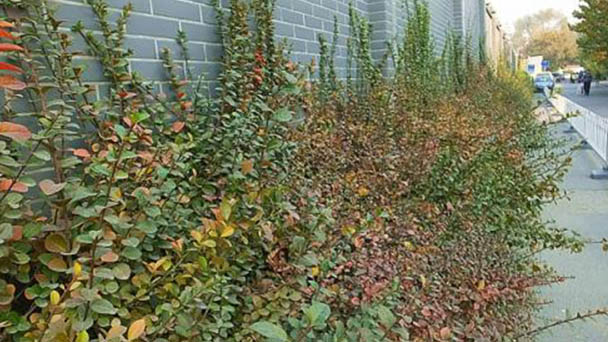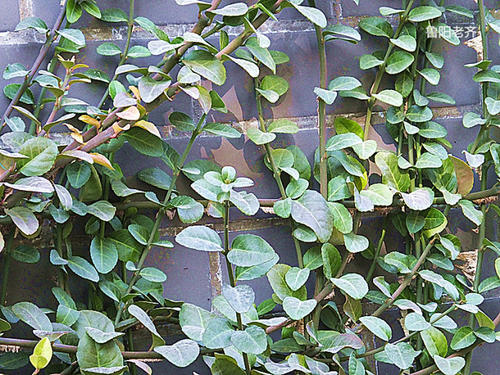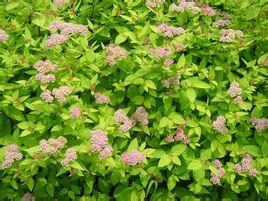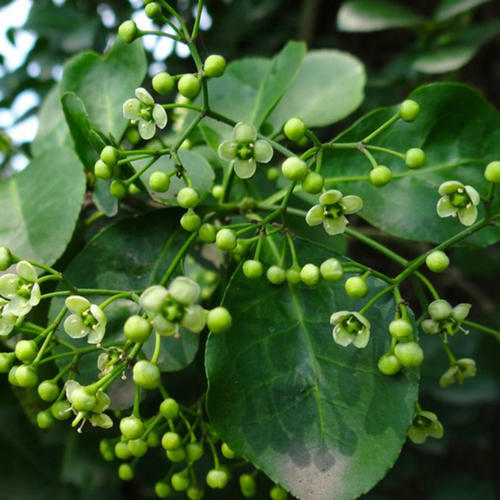Wintercreeper (Euonymus fortunei) profile
Written by Maggie
Nov 03 2021

Wintercreeper (Euonymus fortunei), also called the spindle, Fortune's spindle, winter creeper, is an evergreen vine shrub of the genus Epiphyllum in the family Epiphyllum. Wintercreeper is up to several meters high.
Wintercreeper picture

Morphological characteristics of wintercreeper
Branches and leaves
Wintercreeper is an evergreen vine shrub, 1 to several metres tall; Branchlets are fusiform inconspicuous. Leaves are thin leathery, elliptic, oblong elliptic or long obovate, wide variation, can narrow to nearly lanceolate, 3.5-8 cm long, 1.5-4 cm wide, apex obtuse or acute, base cuneate, marginal teeth shallow and not obvious, lateral veins subtle and small veins are not obvious at all; Petiole is 3-6 mm long.
Flowers
Cymes of Wintercreeper are 3-4 branched; Pedicels are 1.5 -- 3 cm long, first branches 5 -- 10 mm, second branches less than 5 mm, final cymes densely flowered with 4 -- 7 flowers, branches with a single flower in the center, pedicels ca.5 mm; White-green, 4-numbered, ca. 6 mm in diam. Disk is square, ca. 2.5 mm in diam. Filaments are slender, 2-5 mm long, anthers rounded cordate; Ovary is trigonal, tetragonal, stout and conspicuous, style ca. 1 mm.
Fruit
Capsule of Wintercreeper is pink, pericarp smooth, subglobose, 6-12 mm in diameter; Inflorescence pedicels are 2-3.5 cm long; Fruit pedicels are 5-8 mm long; Seeds are oblong elliptic, brown, bright red aril, whole seed.
Wintercreeper's ecological habits
Wintercreeper likes warm, wet environments, like sunshine, and are also tolerant of shade. Under the conditions of abundant rainfall, fog and high soil and air humidity, the plants grow well. Wintercreeper has strong adaptability to soil, acid and alkali and neutral soil can grow normally, can be cultivated in sand, limestone mountain, suitable for loose, fertile sandy loam growth, suitable for growing temperature of 15-30℃.
Wintercreeper disease control
Wintercreeper has strong resistance to disease, and no disease has been found in cultivation tests.
Wintercreeper insect pest is mainly leaf rolling moth, mostly occurs in nurseries or planting density is high, the plant is relatively shady place, with the larvae nibble young stem and leaves or bite off the young stem harm.In the incipient stage, the larvae can be sprayed with 90% trichlorfon soluble powder 800-1000 times liquid, or 90% trichlorfon crystal 1000 times liquid.
Wintercreeper's distribution area
Wintercreeper is produced in China Jiangsu, Zhejiang, Anhui, Jiangxi, Hubei, Hunan, Sichuan, Shaanxi and other provinces. Wintercreeper grows in the hillside jungle.
The type specimen of Wintercreeper was collected from Zhejiang.
How to grow and care for wintercreeper
Light
Wintercreeper flourishes in full solar to phase shade, however it can tolerate a massive quantity of shade.
Soil
Wintercreeper grows without problems in average, medium moisture, well-drained soil. It prefers alkaline soil however will tolerate many one of a kind soil conditions, consisting of compacted soil, a variety of pH levels, and dry (drought) soil conditions. But it does no longer do properly in moist soil.
Water
Water the Wintercreeper when the pinnacle three inches of soil are dry. If the plant is already established, it can additionally tolerate drought conditions. If you stay in a cold-winter climate, you can assist forestall frequent wintry weather problems, such as desiccation, by watering the flora nicely in the fall, earlier than the floor freezes.
Temperature and humidity
Wintercreeper euonymus does properly in all local weather stipulations located in USDA hardiness zones 5 to 9. In areas with harsh winters, Wintercreeper can go through some iciness injury from ice and dramatic temperature fluctuations. Wrapping flora in burlap can assist reduce damage. Fortunately, this resilient plant is very right at getting better from the outcomes of winter.
Fertilizer
As an evergreen shrub with insignificant flowers, wintercreeper normally wants no fertilizer for familiar health. If desired, you can feed it as soon as 12 months in the fall, using a small quantity of fertilizer utilized at least two inches from the plant's trunk.
Pruning
Pruning can be accomplished both to manipulate the unfold of the plant or to preserve it in a favored shape—such as to hold it in a mounded form instead of permitting it to unfold as a ground cover. Major pruning ought to be completed after summer time flowering is complete. Make positive sterilized slicing equipment after every cut. (Find more winter plants here.)

Propagating wintercreeper
Wintercreeper is without difficulty propagated from new-growth cuttings. With sterilized reducing shears, take a 4- to 6-inch size of stem that has at least four pairs of leaves. Strip off the backside pair of leaves and region the reducing in moist potting mix. Keep the potting combine moist till roots at least 1 inch lengthy have emerged from the nodes in the place the leaves have been removed, then transplant into a large pot. Make positive to harden the plant off earlier than transplanting into the garden.
Varieties of wintercreeper
There are three types of wintercreepers:
Euonymus fortunei var. fortunei is native to China and Korea. This is the sole range that points to the green-and-gold leaf pattern.
Euonymus fortunei var. Radicans are native to Japan. This range has undeniable inexperienced leaves.
Euonymus fortunei var. vegetus is native to northern Japan. Some specialists say it is now not wonderful from var. radicans.
Additionally, there are various advocated cultivars, although now not all will provide the emerald-and-gold coloring that many gardeners desire:
'Emerald Gaiety' has inexperienced and white leaves.
'Emerald 'n' Gold' has inexperienced leaves with extensive yellow margins. It can mound into a shrub four to 5 toes in height.
'Emerald Surprise' has inexperienced foliage with smaller yellow margins.
‘Canadale Gold’ has sleek leaves with golden margins. It is a mounding form, however is additionally excellent for vine training.
'Minimus' is a small mounding cultivar, developing to solely about 18 inches however with a 6-foot spread. Known as "baby wintercreeper," it has pretty small leaves.
'Coloratus' is acknowledged as a purple-leaved wintercreeper. It is a low spreading cultivar, with leaves that have purplish colour on the undersides.
Wintercreeper uses
Wintercreeper garden use
Wintercreeper to cover the best green foliage plants, especially its color leaf variation varieties, more have higher ornamental value. Summer is green and yellow, like a sea of green with golden waves;In autumn and winter, the leaves are bright red, and it has become a sea of red, which is an excellent plant for landscaping in color.
Wintercreeper has a variety of uses in landscaping and beautification: Wintercreeper has a strong climbing ability. It is often used to cover the walls, rocks, or climb on the flower grid to form a vertical green barrier in landscaping. Vertical greening configuration tree species, Wintercreeper can be planted with Reptile isolated plant, so that the two plants climb on the wall at the same time, in winter, Reptile deciduous dormant, Wintercreeper leaves red luster, lush, is very beautiful; Wintercreeper resistance negative especially strong, planted in the shady side of the building or dense buildings can not direct sunlight, can also grow well, showing the tenacious ability to adapt; Wintercreeper is grown into a "ball shape" that is comparable to a large leaf boxwood ball.
Wintercreeper grows fast, very resistant to pruning, and the old branches on the hidden bud germination force is strong, so after the ball, the base of lush and plump branches and leaves, very beautiful. Wintercreeper is hardy in winter, and it has been increasingly used in Beijing's landscaping.
Wintercreeper can resist sulfur dioxide, sulfur trioxide, hydrogen oxide, chlorine, hydrogen fluoride, nitrogen dioxide and other harmful gases. It can be used as green tree species in industrial and mining areas with serious air pollution.
Medical use
Wintercreeper can activate collaterals, stop bleeding and eliminate blood stasis. Wintercreeper can treat lumbar muscle strain, rheumatic arthralgia, hemoptysis, blood collapse, irregular menstruation, fractures, trauma and bleeding.

Read Next:
10 Best Winter Plants to Brighten Your Winter Garden
Latest Updated
- Benefits of Bugleweed - 7 Science-backed Health Benefits
- Bugleweed Dangers & Side Effects - Is It Poisonous?
- How to Plant Evergreen Trees - What You Should Know
- When to Plant Evergreens - Grow Guide for Evergreen Trees
- 12 Wonderful Evergreen Shrubs for Your Garden
- 12 Popular Evergreen Plants with Pictures for Beginners
- When And How To Prune A Lilac Bush Like a Pro
- How to Grow & Care for Lilac Vine (Hardenbergia Violacea)
- Japanese Lilac Tree (Syringa Reticulata) Care & Propagation Guide
- Shumard Oak Pros and Cons - What to Know
Popular Articles
- Winter maintenance of Antirrhinum Majus
- How to Grow Terminalia Mantaly Tree
- How to Grow and Care for Crossostephium Chinense
- How to grow Antirrhinum Majus in spring
- Peristeria Elata (Dove Orchid) Profile: Info & Care Guide
- Underwatered Snake Plant (Sansevieria Trifasciata) - Signs And How To Fix
- How to Care for Brazilian Jasmine Plant (Mandevilla Sanderi)
- How to Grow & Care for Graptopetalum Purple Delight in Summer
- Rosa Chinensis (China Rose): Plant Growing & Care Tips
- How to Care for Baby Sun Rose (Aptenia Cordifolia)